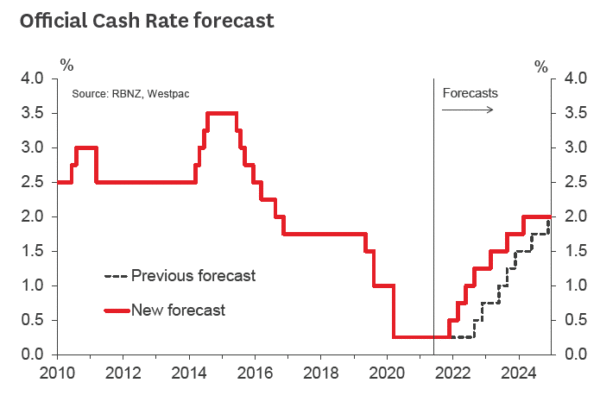- We now expect the Reserve Bank to start raising the OCR from November this year.
- The cost pressures resulting from Covid-19 disruptions are well known.
- The more significant development for the RBNZ is the growing evidence that demand is running hot.
- Strong demand increases the risk that supply- related price shocks can become more enduring.
- Next week’s Monetary Policy Review is likely to start setting the scene for a normalisation of monetary policy, without committing to a particular timing at this stage.
The May Monetary Policy Statement left the impression that the Reserve Bank was quite comfortable with how the economy was tracking. Activity was continuing to recover from the effects of the Covid-19 pandemic, albeit unevenly, and while inflation was expected to lift in the near term, this was viewed as temporary.
It’s unlikely that next Wednesday’s Monetary Policy Review will be anywhere near as sanguine. In the intervening weeks, we’ve seen a string of strong activity indicators, the housing market has remained perky even in the face of new restraining measures, and reports of rising prices and labour shortages have escalated dramatically.
Admittedly we’ve been caught on the hop too. Having just recently brought forward our forecast of the first OCR hike to August 2022, we’re now questioning whether the RBNZ has even that much time on its side. We now expect the first OCR hike to occur in November this year, with follow-ups in February and May next year, and a further gradual tightening over the following years
It’s been apparent for some time that Covid-19 has largely manifested as a supply-side shock in New Zealand’s case, with disruptions to supply chains, soaring shipping costs, and a loss of access to overseas workers. The key question for us has been whether the demand conditions were in place for that initial price spike to translate into an ongoing series of price increases.
In that respect, yesterday’s Quarterly Survey of Business Opinion was a big deal for us. There was evidence of strong demand throughout the survey – measures of activity, hiring and investment were all up substantially compared to three months ago, and profitability was seen as improving even in the face of mounting cost pressures. That strength wasn’t universal – the building industry is clearly running red-hot, while retailers are still struggling to improve their profitability – but it was widespread enough for us to take notice.
The questions on labour market conditions were also notable. Not surprisingly, firms said that workers are becoming extremely difficult to find. But the key measure for us was a sharp rise in reported labour turnover – heavily concentrated in the building sector, but not limited to that. That provides, at least, circumstantial evidence that employers have been willing to bid up in order to lure workers away from other firms. And the fact that they can afford to do so – an element that’s been missing in times past – is another marker of strong demand.
Putting this all together leaves us with a picture of an economy that is already running close to its potential, even with the ongoing closure of the border. And with firm demand and mounting supply pressures, inflation is set to rise much higher than the RBNZ expected over the coming quarters.
There’s still a good case to be made that some of the current inflation pressures will be temporary, or at least non-repeating. As the global economy reopens, we’d expect that supply chain disruptions will be ironed out, demand for physical goods relative to services will normalise, shipping costs will come off their peak, and employers that are bidding up now to deal with their current labour shortages will look for ways to claw back those higher pay rates. That could set the scene for a period of stubbornly low wage and price growth a few years down the track.
But the issue is whether the RBNZ can hold out for that long. With demand running hot, there’s a greater risk that recent price hikes feed into people’s expectations of inflation, and once that becomes embedded it’s hard to dislodge again.
We expect that when OCR hikes begin, the pace will be gradual – at three-month intervals initially, then stretching out to six-month intervals. As others have noted, households have taken on significantly more debt since the last time that interest rates rose, so a little could go a long way in terms of squeezing household budgets and dampening demand
What to expect from the RBNZ statement.
Next week’s policy announcement is a Monetary Policy Review, which means a shortened process and no new published forecasts. The RBNZ may want to hold off some of the more difficult judgements until the August Monetary Policy Statement, but the July statement is likely to set the scene for an eventual policy tightening.
The RBNZ will acknowledge that domestic activity is showing some strong momentum. The single biggest surprise for the RBNZ was the 1.6% rise in March quarter GDP, against their forecast of a 0.6% drop. That result will probably also prompt the RBNZ to revise up its assumption about the economy’s potential, but the net effect will still be a significant positive surprise.
The RBNZ will also acknowledge the extent of current price pressures, and the increased risk that some of these price rises could become persistent rather than temporary. Unusually, the RBNZ review comes a couple of days before the June quarter CPI release.
The May statement concluded in a similar fashion to previous statements:
“The Committee agreed to maintain its current stimulatory monetary settings until it is confident that consumer price inflation will be sustained near the 2 percent per annum target midpoint, and that employment is at its maximum sustainable level. Meeting these requirements will necessitate considerable time and patience.”
That language will undoubtedly have to change. While sustained inflation and maximum sustainable employment aren’t a certainty, it’s clear that they are no longer a “considerable time” away. And given that monetary policy settings are already so stimulatory, starting the normalisation process early will reduce the risk of having to tighten rapidly later.
As for the RBNZ’s unconventional easing measures, we suspect that any formal statement on their future will wait until August. But for the record:
- The Large Scale Asset Purchase programme has already been substantially wound down, with the current pace of purchases ($200m per week) falling well below the Treasury’s rate of issuance ($500m per week).
- The Funding for Lending Programme for banks will largely take care of itself. The lending rate is tied to the OCR, so the prospect of a series of OCR hikes means that it won’t be seen as a cheap source of funding for much longer













